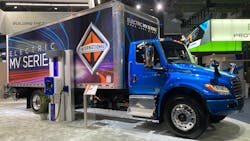Truck OEM execs talk EV charging infrastructure pain points
LONG BEACH, California—The tipping point for commercial battery-electric vehicles is projected to happen around 2030. As charging infrastructure challenges loom, however, the road to commercial fleet electrification will be a bumpy one.
That was at least the sentiment heard around the Long Beach Convention Center during this year’s Advanced Clean Transportation (ACT) Expo.
Widespread EV fleet adoption is still a point of confusion for many fleets and dealers, who, in general, feel that shared views and perspectives are lacking within the industry, Mathias Carlbaum, president and CEO of Navistar, told FleetOwner.
See also: Electrification at a 'tipping point' as fleets explore adoption
“Over time, more and more dealers and customers will find their way here because it’s a learning curve for everybody,” Carlbaum said. “We have to rethink the way we do business, the way a customer runs their fleet operation, and the role of all the different players in the value chain. It won’t look the same as it does today.”
“Everyone is dipping their toes in the water,” he added. “How will I charge this? What happens to the battery at the end of the cycle? This [transition] is moving so fast, will [assets] be out of date in three or four years? All of these are concerns.”
Today, some of those early EV adopters are partners of the Volvo LIGHTS (Low Impact Green Heavy Transport Solutions) project. Volvo LIGHTS was a three-year collaboration between Volvo Trucks North America, South Coast Air Quality Management District (AQMD), and 12 other organizations. Partners worked together to design a blueprint to introduce zero-tailpipe emission battery-electric trucks and equipment into the market at scale.
In a newly released Volvo LIGHTS Lessons Learned Guidebook, Volvo Group published insights gained during its three-year battery-electric freight movement project.
One challenge cited in the guidebook is that public charging sites for heavy-duty trucks are especially difficult to plan. Existing state laws must first allow entities other than existing utilities to re-sell electricity to zero-emission truck owners, the guide stated. Then, once allowed, considerations ranging from site design, needed power expansion, and coordination with municipalities and planning authorities can be cumbersome.
The process is slow, taking some 12 to 18 months to get permits and charging infrastructure in place, Peter Voorhoeve, president of Volvo Trucks North America, told FleetOwner. It’s also important to look at the right charging equipment, he added.
Battery circularity also is a separate leg in Volvo Energy’s business for batteries at end of life. The goal here is to remove a linear production model by taking the battery back into Volvo’s system for parts manufacturing, recycling, or repurposing.
When it comes to addressing charging challenges, Navistar’s Carlbaum said that as commercial electric vehicle volume picks up to levels of scale, truck OEMs need to develop turnkey charging solutions, which will be particularly important for helping smaller fleet operators.
Carlbaum also pointed to the need of support and energy storage solutions for end-of-life batteries. When battery demand increases by 2030, one challenge will be sourcing materials, he explained.
“I heard that the expected amount of lithium by 2030 will be 2,000% more than what it is today,” Carlbaum said, noting that over time, creating a more circular economy for batteries is logical both from environmental and business perspectives.
“Don’t underestimate what technology brings in,” Carlbaum said. “It is the door opener for all of this, and we will find a way forward for the planet and because it will make so much business and economic sense.”
About the Author

Cristina Commendatore
Cristina Commendatore is a past FleetOwner editor-in-chief. She wrote for the publication from 2015 to 2023.


